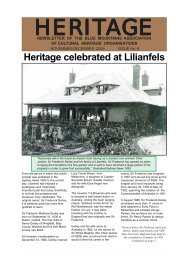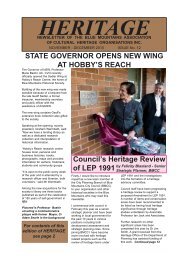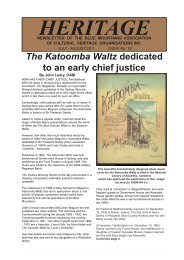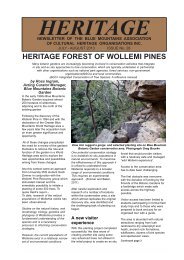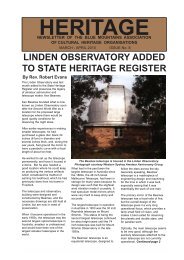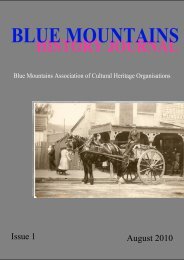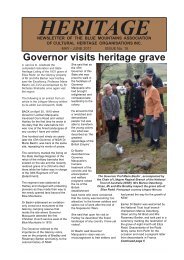Newsletter No - Blue Mountains Association of Cultural Heritage ...
Newsletter No - Blue Mountains Association of Cultural Heritage ...
Newsletter No - Blue Mountains Association of Cultural Heritage ...
Create successful ePaper yourself
Turn your PDF publications into a flip-book with our unique Google optimized e-Paper software.
PROPOSED NSW PLANNING REFORMS<br />
OVERLOOK HERITAGE VALUE<br />
By Margi Fallon <strong>Heritage</strong> Consultant Architect<br />
MANY may be aware <strong>of</strong> the<br />
proposed New Planning System for<br />
NSW as outlined in the green paper<br />
released for public comment in July<br />
this year. Submissions for<br />
individuals closed on September 14<br />
and for councils on October 5.<br />
It was clear from many <strong>of</strong> the<br />
submissions that the proposed<br />
planning reforms will have a major<br />
effect on community consultation,<br />
design quality, environmental<br />
protection and heritage within the<br />
state.<br />
The reforms are being developed<br />
with the primary aim <strong>of</strong> speeding up<br />
development in the state, with many<br />
risks attached.<br />
Despite many reservations being<br />
expressed from community,<br />
environment, local government and<br />
heritage groups around the state,<br />
the government is proceeding<br />
quickly to the development <strong>of</strong> the<br />
white paper which will go before<br />
parliament for ratification early to<br />
mid next year.<br />
OBJECTIVES OF THE<br />
PROPOSED PLANNING<br />
REFORMS<br />
The key drivers <strong>of</strong> this reform are<br />
‘growth and development<br />
outcomes’, and these will occur at<br />
the cost <strong>of</strong> quality, environment and<br />
good design. The removal <strong>of</strong> the<br />
word environment from the naming<br />
<strong>of</strong> the planning instruments is<br />
ominous.<br />
The word “heritage” also barely<br />
appears in the green paper.<br />
A stated objective <strong>of</strong> greater<br />
community involvement will not be<br />
met as this is proposed to be<br />
restricted to the strategic planning.<br />
There needs to be community<br />
consultation at the development<br />
end <strong>of</strong> the process as well as the<br />
strategic end <strong>of</strong> the process.<br />
An inverted triangle principal <strong>of</strong><br />
planning, proposed by the<br />
Productivity Commission, sets the<br />
concept <strong>of</strong> a top down planning<br />
system rather than a merit based<br />
assessment system.<br />
This will be difficult to achieve<br />
without a very careful and<br />
coordinated approach that enables<br />
the local and character needs to be<br />
addressed at the state level.<br />
It is difficult to see how this can<br />
happen in reality.<br />
The community is unlikely to<br />
engage at a state level, and will be<br />
more involved at a local level.<br />
However, what is left to decide<br />
strategically at a local level will be<br />
pretty small as the state and<br />
regional plans will provide the<br />
framework through which the local<br />
planning can happen.<br />
The streamlining <strong>of</strong> the planning<br />
process to remove or reduce the<br />
scope <strong>of</strong> merit based assessment <strong>of</strong><br />
design will need to either be a very<br />
complex system <strong>of</strong> clearly defined<br />
code requirements to enable the<br />
“tick box “ to provide for good<br />
outcomes, or it will create a<br />
proliferation <strong>of</strong> the lowest common<br />
denominator <strong>of</strong> design and urban<br />
outcomes.<br />
The outcome <strong>of</strong> this will only be<br />
noticed when it is too late. (<strong>No</strong>ting<br />
that the majority <strong>of</strong> small to medium<br />
scale developments are not<br />
designed by design trained<br />
pr<strong>of</strong>essionals.)<br />
cover urban, coastal, regional, outer<br />
west and other local areas from a<br />
state level concept.<br />
The environment <strong>of</strong> NSW is diverse<br />
and the needs <strong>of</strong> the various<br />
communities are diverse.<br />
The drivers and focus <strong>of</strong> these<br />
reforms are clearly based on<br />
Sydney urban growth and<br />
development issues and these<br />
issues are not as relevant in<br />
regional NSW.<br />
What is relevant is decentralisation,<br />
and infrastructure. These are also<br />
included in the reforms and the<br />
implementation <strong>of</strong> the reforms with<br />
a greater focus on regional NSW<br />
will enable this issue to be<br />
potentially addressed.<br />
The planned strategic management<br />
system <strong>of</strong> state to regional to<br />
subregional to local, will only work if<br />
the manning <strong>of</strong> the various <strong>of</strong>fices<br />
at each level are located<br />
appropriately (ie regional and sub<br />
regional <strong>of</strong>fices in their relevant<br />
regional areas, manned by regional<br />
pr<strong>of</strong>essionals, not Sydney based<br />
ones.)<br />
The manning <strong>of</strong> the “Independent”<br />
bodies suggested in the report is<br />
heavily weighted to the planning<br />
and developer pr<strong>of</strong>ession.<br />
However, for a good design<br />
outcome a broad range <strong>of</strong><br />
pr<strong>of</strong>essionals need to be involved in<br />
the strategic planning bodies<br />
including :<br />
<strong>Heritage</strong> pr<strong>of</strong>essionals, Aboriginal<br />
cultural pr<strong>of</strong>essionals,<br />
environmental pr<strong>of</strong>essionals,<br />
planning pr<strong>of</strong>essionals, urban<br />
design pr<strong>of</strong>essionals, and<br />
community representatives.<br />
The general community will not be<br />
able to understand enough <strong>of</strong> the<br />
end result to be able to fully engage<br />
in strategic planning unless they are<br />
very honestly and clearly trained<br />
and consulted by highly trained<br />
pr<strong>of</strong>essionals, with scale models <strong>of</strong><br />
what will land on the ground as a<br />
result.<br />
While the green paper appears to<br />
recognise local government, the<br />
regional and subregional system<br />
has the potential to remove the role<br />
and power <strong>of</strong> local government in<br />
planning.<br />
This will not have a good outcome<br />
as NSW is a diverse culture and it<br />
will not be possible to adequately<br />
The last group -- community<br />
representatives, does at its heart<br />
need to involve local government<br />
councillors. I don’t believe local<br />
community elected representatives<br />
can be removed from the<br />
consultative and decision making<br />
system. After all, that is what they<br />
have been elected to do – advocate<br />
for the local community.<br />
HERITAGE 14<br />
<strong>No</strong>vember - December 2012




